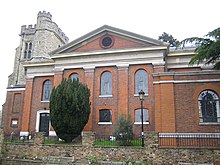St. Mary's Church (Twickenham)
From the (Anglican) Church of England is part of St. Mary's Church in Twickenham , Middlesex , a suburban neighborhood in southwest London Borough of Richmond upon Thames is in the nave a baroque church of the early 18th century, the Gothic next to the preserved old church tower Predecessor building made of limestone from Kent stands.
Building history
Although it is assumed that a simple church stood on this site as early as the middle of the 12th century, Twickenham is first mentioned in documents with Vicar Alan von Twickenham in the accounts of Count Richard of Cornwall around 1296/1297. The church itself is first mentioned on November 12, 1332. It was subordinate to the Abbey of Saint-Valery-sur-Somme and was like all French priories in England by King Edward III in 1337 . expropriated. The preserved medieval church tower is dated to the 14th century. The associated former nave collapsed on April 9, 1713 due to its disrepair after neglecting maintenance. At that time, Twickenham was already in the gentrification phase . Within a year it was rebuilt with philanthropic donations from the circle of the parishioners as a new building according to a new early Georgian concept of the member of the church council and court painter Sir Godfrey Kneller of Whitton based on the plans of the proven architect John James . The north facade to the Thames and the south facade of the nave to the village became the main facades, which were executed in brick and enhanced with Doric style elements, the new building consisting of the nave and choir in a remarkable contrast to the remaining medieval structure of the tower.
Furnishing
- The oldest memorial in the church is a stone slab for Richard Burton († 1443), the cook of King Henry VI.
- Grinling Gibbons : Memorial to the Ashe Family
organ
The organ was built in 1996 by the organ builder Harrison. The instrument was built in an organ case from 1966, which was designed based on an organ case from the 18th century in Sculthorpe Parish Church (Norfolk). The organ has 20 stops on two manuals and a pedal . The Spieltrakturen are mechanically (tracker actions), the Registertrakturen are electric.
|
|
|
||||||||||||||||||||||||||||||||||||||||||||||||||||||||||||||||||||||||||
- Coupling : II / I, II / II (sub-octave coupling), I / P, II / P
Stained glass
The Victorian stained glass on the church windows fell victim to the German air raids on London in 1944. They have been renewed and are reminiscent of personalities such as the English governor of Virginia Sir William Berkeley († 1677), whose older brother Lord Berkeley of Stratton was buried in the church.
Burial sites in the church
Several famous figures in the history of England found their final resting place in the church.
- The Admiral John Berkeley of Stratton
- Lady Elgin († 1810, widow of Charles Bruce, 5th Earl of Elgin), governess of Crown Princess Charlotte Augusta of Wales , who later died in childbirth .
- Godfrey Kneller , his coat of arms in the westernmost window on the north side also marks the location of his otherwise unrecognizable grave. His self-designed epitaph, made by John Michael Rysbrack after his death , ended up in Westminster Abbey because his ideal place in St. Mary's was already blocked by the plaque for Pope's parents.
- Alexander Pope , under a stone slab, inscribed with the letter "P", next to a bronze plaque dedicated to him by followers. A relief and the epitaph for his parents also remind of him in the church.
Churchyard
- Crypt of General William Tryon (1729–1788), British governor of North Carolina and New York
literature
- Richard Stuteley Cobbett: Memorials of Twickenham: parochial and topographical , Smith, Elder & Co., 1872
- Frederic Chapman, Thomas R. Way: Architectural Remains of Richmond Twickenham Kew Mortlake and Petersham , Wildhern Press, 2008, p. 63 ff. (Digitized in English)
Individual evidence
Web links
Coordinates: 51 ° 26 ′ 49 ″ N , 0 ° 19 ′ 30.5 ″ W.
